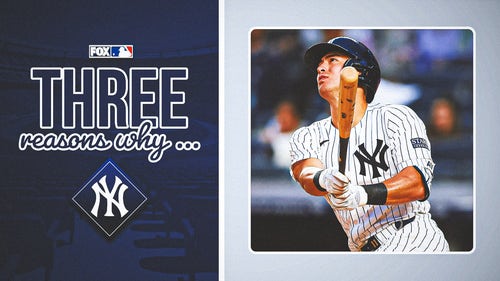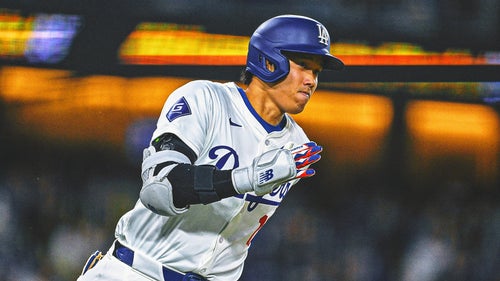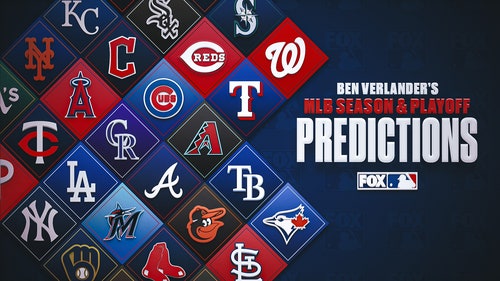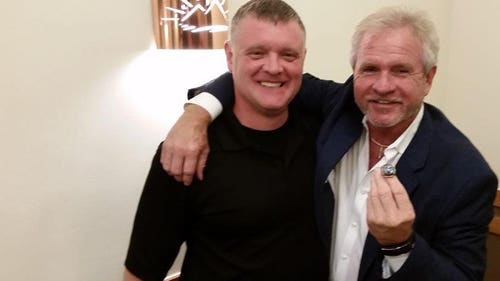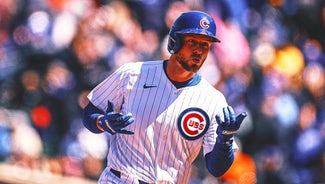
Five things to watch for on Hall of Fame election day
The Hall of Fame election results show still isn't quite ready for prime time, but as with last year, Hall president Jeff Idelson will announce the results live on MLB Network at 6 p.m. ET on Wednesday, with both MLB.com and the Hall's website streaming it as well. What follows here is my quick guide to five key things to watch for.
Please note that all references to pre-election voting percentages refer to Ryan Thibodaux's indispensable Ballot Tracker, all references to projected results refer to Nathaniel Rakich's system, and all references to odds of election refer to Jason Sardell's system, all of which I highlighted last week.
1. The long wait is over for Jeff Bagwell and Tim Raines
Via the Tracker, which as of 9 p.m. Eastern on Tuesday had logged 229 public ballots and seven anonymous ones—an estimated 54.3% of the electorate—both Raines (89.4%) and Bagwell (88.5%) appear to be safe bets for election. In a season of polling uncertainty, it's incorrect to call any outcome a lock, and while those percentages will likely fall by a few points, both have already picked up more votes from among the returning voters who left them off their ballots last year than the margin by which they fell short. Bagwell, who missed by 15 votes last year, has gained 21 votes, while Raines, who missed by 23, has gained 29 votes. Neither has lost a single voter who included them on his or her ballot last year.
The relative lack of suspense regarding this pair should not obscure the significance of their long-overdue enshrinement. Raines, who is in his 10th year of eligibility, debuted at 24.3% in 2008; his would be the lowest share of any first-year candidate who was eventually elected by the writers since Bert Blyleven, who received 17.5% in 1998 and was finally elected in 2011. Through no fault of his own, Raines lost five years of eligibility via the Hall's 2014 rule change shortening eligibility windows from 15 years to 10, which looked as though it might be a crippling blow to a candidacy that had just fallen six points to 46.1% in the previous election. Assuming he tops 75%, he'll join Red Ruffing (1967), Ralph Kiner (1975) and Jim Rice (2009) as candidates elected in their final year of BBWAA eligibility. Bagwell, who is in his seventh year of eligibility, debuted at 41.1% in 2011 and has waited longer than any recent candidate who was eventually elected by the writers beside Raines and Blyleven.
As with Blyleven, voters who initially focused on the traditional statistics of Raines and Bagwell were slow to come around on them, often fixated on their shortcomings rather than their accomplishments. Both battled injuries that left them short of milestones (3,000 hits for Raines, 2,500 hits and 500 homers for Bagwell) and when both made it to the World Series, they were part-time players in the twilights of great careers. Both had a stigma attached to their names, in that Raines battled a cocaine problem early in his career but met it responsibly, and Bagwell admitted to using androstenedione in 1999, back when it was still legal, then was subject to voters voicing suspicions about further use despite a lack of evidence. Both rate as very strong candidates according to my JAWS system—Bagwell is sixth among first basemen, Raines eighth among leftfielders—and have benefited from the evolution of the electorate to include voters more familiar with advanced statistics. That means both new voters who have long since become fluent in WAR, JAWS, OPS+ and so on before getting their first ballots, as well as older ones willing to reevaluate their previous positions. Like Blyleven, Raines and Bagwell both also benefited from a grassroots campaign of bloggers and social media users who have not been shy about campaigning on their behalf, helping to persuade actual voters at a time when ballot space is at a premium.

2. Genuine suspense over who will join that pair
As of that 9 p.m. Tuesday cutoff, three candidates were in the "too close to call" zone. First-year candidate Ivan Rodriguez had received 78.4% of the revealed ballots, second-year candidate Trevor Hoffman was at 72.5%, and first-year candidate Vlad Guerrero was at 71.2%. As I wrote last week, I expect all three to converge toward 75% because of the general trends regarding public ballots and private ones, namely that candidates connected to PED allegations, even tenuously, tend to receive less support from the private ballots than the public ones, while candidates whose cases rely heavily on traditional stats tend to receive more support from the private ballots (which tend to come from older and possibly less professionally active voters) than the public ones.
Rodriguez was allegedly injected by Jose Canseco, according to the latter's 2005 book, Juiced, but never tested positive or was named in the Mitchell Report. Guerrero is about eight points below the JAWS standard among rightfielders but owns a .318 lifetime batting average, an omission that would be unprecedented. Hoffman is below the JAWS standard among relievers but once held the all-time saves record and still ranks second in the category.
Rakich, who explained his projection system at The Hardball Times, uses a model that averages the public-private differential over the past three elections (or fewer, if that’s all that’s available) to calculate an adjustment factor for each candidate. For first-year candidates, he "finds 'veteran'” candidates with whom the rookies’ votes are well correlated and adjusts their exit polls proportionally." His estimates show Hoffman winding up at 75.8%, Rodriguez at 74.5% and Guerrero at 71.5% (click here for an update). Keep in mind that Rakich's average error last year was 1.5 points, and his largest error was 3.5 points, which is enough to flip the verdict on any of these three.
Sardell, who uses a Bayesian probability model with a public-private adjustment factor based on categorizing 2016 voters “into a general category (full ballot, anti-Bonds, etc.) and treat[ing] 2017 data as exit polls,” estimated at the point when there were 232 ballots in the Tracker that Rodriguez's chances of election are 52% (down from 65% last week), Hoffman 44% (down from 50%) and Guerrero 16% (waaay down from 55%). Which leads us to…
3. Big Classes from Big Ballots
If you've followed my Hall of Fame coverage, you know about the ongoing ballot backlog, which largely owes to a lack of consensus with regards to PED-tinged candidates, and you know about next year's arrival of another crop of strong candidates, namely the JAWS-approved Chipper Jones, Jim Thome and Scott Rolen, as well as Andruw Jones (slightly below the standard but 10th among centerfielders). Given those factors, another big Hall of Fame class this year is something to hope for, even after nine candidates were elected over the previous three cycles. While we've seen three- and four-man classes from the BBWAA as recently as 2014 (Tom Glavine, Greg Maddux and Frank Thomas) and 2015 (Craig Biggio, Randy Johnson, Pedro Martinez and John Smoltz) respectively, those are comparatively rare. That 2014 class was the only trio in this century; there have ben just eight in voting history ('37, '39, '54, '72, '84, '91 and '99 being the others). Meanwhile, there have only been two other four-man classes, in 1947 and '55. The only other time there's been a five-man class was in the Hall's inaugural election in 1936.

All of which is to say that there's still a shred of a chance that we see some real history made on Wednesday. I asked Sardell to crunch some numbers on various permutations, and according to his calculations, there's roughly a 4% chance of a five-man class, a 27% chance of a four-man class, a 47% chance of a three-man class, and a 23% chance of a two-man class (the total exceeds 100% due to rounding). Sardell did offer a caveat that those calculations assume the candidates are independent, which isn't ideal: "For example, more anti-PED voters than expected may help Vlad at the expense of Pudge, and Vladand Hoffman seem to be competing for ballot space on full ballots." All of which is to say no warranty is offered if using those odds for gambling purposes.
The large classes owe to the recent trend of a majority of voters using all 10 slots on their ballots. Reprising data I reported last year that came by way of BBWAA secretary/treasurer Jack O'Connell, from 1995 (when his tenure began) through 2012, only once did even 20% of voters use all 10 slots on their ballots. Since then, it's been a whole new ballgame, and with it, we've seen some of the fullest ballots ever:
| Year | All 10 | AVG Per Ballot |
| 2013 | 22% | 6.60 |
| 2014 | 50% | 8.39 |
| 2015 | 51% | 8.42 |
| 2016 | 42% | 7.95 |
| 2017 | 55% | 8.50 |
Those 2017 numbers are from the Tracker, and at my cutoff time, they're both higher than the records set in 2015. They'll likely fall somewhat but could still wind up on the podium, so to speak. Since 1966, the third-highest average number of names per ballot was 8.36 in 1983, when Brooks Robinson and Juan Marichal were elected while a total of seven candidates cleared 50% of the vote, something that hadn't been done since 1954 and would not be done again until 2014. More on that subject in a bit, but first…
4. The Gruesome Twosome
If there weren't so much suspense about who is getting in, I'd have this higher up but it does appear that the candidacies of Barry Bonds and Roger Clemens have reached a turning point, in that both have received above 60% in the public balloting (63.6% and 62.7%, respectively) and project to finish around 58% according to Rakich's model. That's significant, because in the history of voting, the only candidates to break 50% and not get elected thus far are Gil Hodges, Jack Morris, Lee Smith (whose candidacy is expiring), and the still-eligible Curt Schilling, plus anyone from among the Bagwell/Raines/Hoffman group that doesn't get in.
Two factors could be contributing to the pair's surge. First, the electorate may finally be showing a greater grasp on the nuances of the era, distinguishing between PED use that came prior to the implementation of a testing-and-penalty program in 2004 and what came afterwards while acknowledging that the odds are some PED users have already been elected. Second, there's the recent election of former commissioner Bud Selig, who's widely viewed as having enabled the whole era, and by the way, also participated in collusion in not signing free agents in the late 1980s (including Raines and Morris). By that logic, if Selig's misdeeds aren't disqualifying via the so-called “character clause,” then neither should the pre-testing era ones of Bonds and Clemens.
The eventual election of either candidate isn't automatic, and many voters and fans still feel a deep animosity toward them. But with four years of eligibility remaining, and with the electorate continuing to evolve (when I get my ballot in 2021, I will vote for them without hesitation if they're still on the ballot), their chances of finally getting those bronze plaques are looking good, whether you like it or not.

5. Shapes of Things To Come
Two more candidates are on track to cross the 50% threshold for the first time, and what's more, they're the two candidates who picked up the most ground last year, namely Edgar Martinez (66.1% in the tracker) and Mike Mussina (59.3%). Again, you can expect both to drop a few points once the final results are announced, but after rising from the mid-20s to 43.4% and 43.0% last year, respectively, the pair is now clearly on the path to election. Again, that owes something to the broader acceptance of analytics among the voters, as well as the clearance of milestone-wielding first-ballot honorees. For Martinez, who's in his eighth year of eligibility, it's not a moment too soon, but the good news is it appears he’ll have less ground to make up than Raines—who received 55.0% in 2015—did at the same juncture. For Mussina, who's in his fourth year, time is on his side. In all, that would be nine candidates above the 50% mark, something that has only happened once before, in 1947.
I'll be back with more on Wednesday evening after the announcement of the results. Prior to that, I’ll be discussing the Hall of Fame on MLB Network’s MLB Now show from 2-3 p.m. ET.






































































































































